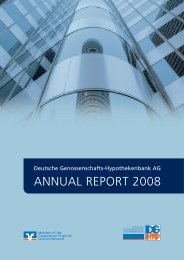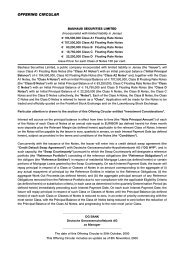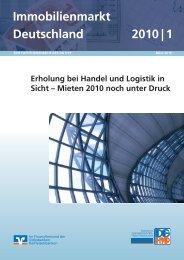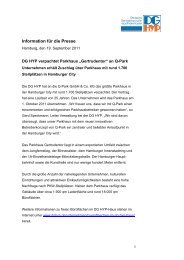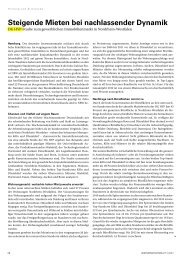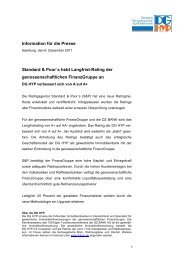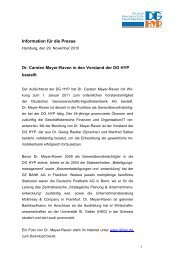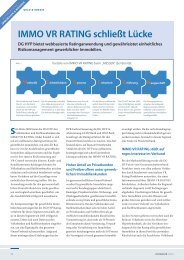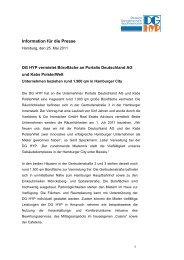Covered Bonds - DG Hyp
Covered Bonds - DG Hyp
Covered Bonds - DG Hyp
You also want an ePaper? Increase the reach of your titles
YUMPU automatically turns print PDFs into web optimized ePapers that Google loves.
<strong>DG</strong> HYP COVERED BONDS – PFANDBRIEFE – QUALITY THE PATH OUT OF THE CRISIS SPECIAL MAY 2009<br />
The PfandBG does not explicitly limit the permitted volume of an issuing bank’s outstanding<br />
pfandbriefe. Instead, the universal capital-adequacy regulations that apply to banks<br />
indirectly limit its lending business – and by extension limit the cover assets it has available<br />
and implicitly cap the permitted amount of its pfandbriefe in circulation.<br />
The provisions governing matching cover and excess cover have been carried over from the<br />
previously applicable laws. The Pfandbrief Banks Act as revised now stipulates that the<br />
respective total volume of the pfandbriefe outstanding of one type must at all times be<br />
covered at their market value by assets of at least the same amount and with at least the<br />
same interest yield. The cover calculation, which is based on the net present value of the<br />
pfandbriefe compared with the cover assets, is subject to special regulatory requirements<br />
that are defined in the Net Present Value Statutory Order (Barwertverordnung). According to<br />
this regulation, the pfandbrief bank has to ensure that the net present value cover is also<br />
maintained in so-called stress scenarios based on big changes in interest and exchange<br />
rates.<br />
The PfandBG still requires the issuer to maintain 2% overcollateralization in relation to the<br />
total volume of its pfandbriefe in circulation in market-value terms, which must be invested<br />
in liquid assets. Voluntary overcollateralisation that exceeds this statutory minimum<br />
requirement is possible. In this context, the PfandBG clearly states that the assets that<br />
exceed the legally required minimum overcollateralization are there to satisfy the claims of<br />
pfandbrief creditors in the insolvency scenario. The minimum market-value<br />
overcollateralization of 2% can also be held as deposits with Deutsche Bundesbank or with<br />
the European Central Bank (ECB), or with all other central banks of European Union<br />
member states.<br />
Permitted substitute cover for pfandbriefe<br />
Substitute cover assets<br />
1.1 Claims on central or local governments in the European Union (EU), European Economic Area<br />
(EEA), Japan, Canada, Switzerland and USA (with the proviso that the risk weighting of the<br />
claims does not exceed 20%).<br />
1.2 <strong>Bonds</strong> guaranteed by a central or local government listed under 1.1..<br />
2 Countries that are full members of the Organization for Economic Cooperation and<br />
Development (OECD) and that were not listed under 1.1.<br />
3 Supranational institutions: European Investment Bank (EIB), International Bank for<br />
Reconstruction and Development (IBRD), Development Bank of the European Council (CEB),<br />
European Bank for Reconstruction and Development (EBRD).<br />
4 Deposits with the European Central Bank or another central bank within the EU.<br />
5 Claims on suitable credit institutions (for example, uncovered bank bonds). The share of the<br />
substitute cover assets of any individual (suitable) credit institution may not exceed 2% of the<br />
volume of pfandbriefe outstanding.<br />
Source: PfandBG<br />
In addition to the ordinary cover assets, the PfandBG also allows substitute cover assets to<br />
be included in pfandbrief cover pools. The bonds and loans permissible (see table) are the<br />
same for the four pfandbrief classes, although their allowed share of the outstanding volume<br />
of the covered bonds differs for the four pfandbrief categories. Unlike the cover pool for<br />
public sector pfandbriefe, the share of substitute cover assets in the cover pool for<br />
mortgage, ship and aircraft pfandbriefe is allowed to be up to 20% of the outstanding<br />
Matching cover in market‐value<br />
terms<br />
2% minimum overcollateralisation<br />
Permitted substitute cover assets<br />
19





